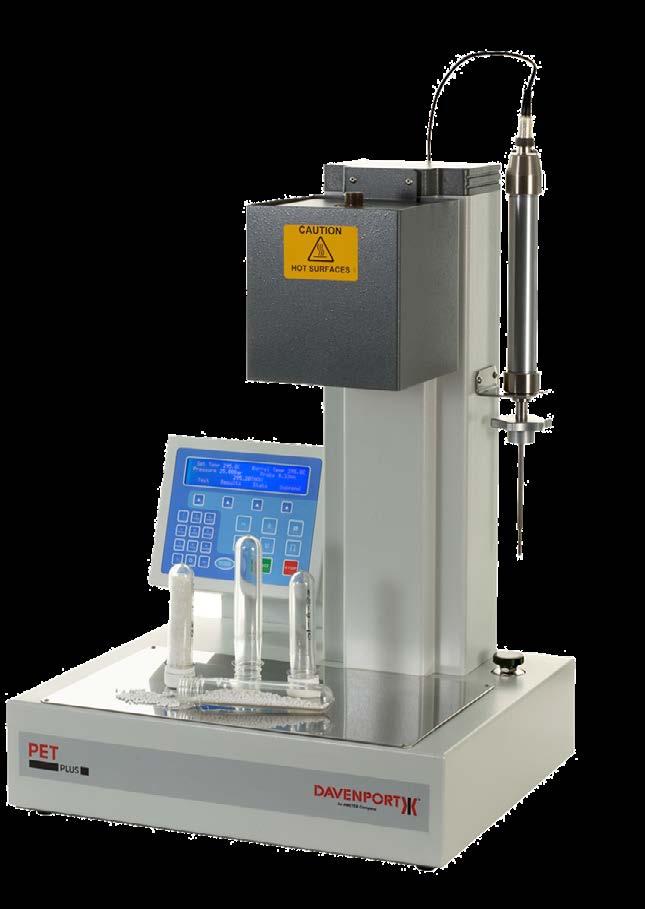
4 minute read
INDUSTRY NEWS: Davenport PETPlus IV for measuring Intrinsic Viscosity of PET Polymer
Source: Bestech Australia
PET (polyethylene terephthalate) is a commercial-grade polymer that is widely used in the manufacture of packaging, fabrics, films, and moulded parts for electronics and the automotive industry.
The most important characteristic that determines the quality of PET polymer is its intrinsic viscosity (IV). IV reflects the melting point of PET polymer, its crystallinity and its tensile strength. IV is dependent on the length of the polymer chain—polymer with longer chain exhibits chain entanglement behavior, which increases its intrinsic viscosity. IV testing is important in selecting the correct grade of PET polymer for particular applications such as fibre grade, film grade or bottle grade. The testing is carried not only in the research and development stage, where new polymers and products are developed, but also across all points of the supply chain process to control product quality and optimise the operating conditions for constant production. Polymer IV can be measured by using the solvent-free approach based on the extrusion of the polymer through a die using a specific instrument. It is a powerful alternative to both solventbased techniques and the free blowing method as the halogenated solvent used for dissolution of the polymer is costly and hard to dispose. The PETPlus IV testing instrument is suitable for this application. It can test polymers at all stages of the process, such as resins, powder, dry granules, molten polymer, performs, PET bottles, film and re-grounded materials. The instrument can measure the degradation factor and provide the mean and standard deviation for each batch. Once the sample is dried, the test can be initiated and completed in less than 20 minutes. Testing the intrinsic viscosity of PET polymer is tricky as it undergoes thermal, oxidative or hydrolitic degradation during processing. The polymer degradation results in the decrease of its IV and increase the number of the carboxyl-end group. The initial degradation rate is fast due to the presence of residual water. First, different samples of molten PET are dried under vacuum. They are then placed into a sealed barrel with a die at the base and forced through the narrow calibrated die at 295°C for 17 minutes. The barrel contains a free space that is filled with nitrogen gas to ensure there is no degradation due to moisture. During this process, the LVDT probe movement against time is recorded and displayed. After extrusion, the software included with the instrument performs a linear regression to obtain the polymer degradation rate and initial melt viscosity. The system then measures the optimum flow rate and calculates intrinsic viscosity. The PETPlus -IV Test Instrument can be operated in stand-alone mode or used with the powerful data analysis software, NEXYGENPlus PET. The instrument displays trends in intrinsic viscosity measurements, thereby enabling easy comparisons between suppliers and batches with full statistical analysis and search facilities. It can also store up to 10 dry samples from the dryer for several days.
Email: enquiry@bestech.com.au GLOBAL TECHNOLOGY LOCAL SUPPORT
Dynamic & Fatigue testing system

Ergonomic, Versatile, High Performance Testing System
Testing wide range of materials:

Advanced/ Biomedical Manufacturing Assemblies Dental Implants
TMF, LCF, Fracture Mechanics, HCF, High-strain rate & Component testing www.bestech.com.au
Call: (03) 9540 5100
Next Generation Phenom XL G2 Desktop SEM Brings Advanced Automation to the Forefront
Source: ATA Scientific
While traditional SEMs remain relatively large and difficult to operate, Thermo Scientific Phenom desktop SEMs provide an alternative that is smaller, faster and now, even easier to use.
Building on the performance of its predecessor, the next-generation Phenom XL G2 Desktop Scanning Electron Microscope (SEM) delivers new automation solutions for quality control (QC), enabling more detailed failure analyses than is possible using optical microscopes. Manual, repetitive tasks can be automated to allow a high volume of samples to be quickly processed and to discover potential failures early to guide rapid adjustment to production processes. Particles, pores, fibres or large SEM images can be automatically characterised and foreign contaminants automatically identified and evaluated for chemical composition. Users can obtain high-quality images in just 40 seconds—three times faster than other desktop SEM systems on the market. Offering an improved resolution of 10 nanometers, the system enables more resolving power and the ability to explore large samples of up to 100 by 100 millimeters. A key feature of the Phenom XL G2 is its easy-to-use, intuitive user interface combining two screens into one for viewing images and performing analysis. With one simple click on the impurity, users can see what elements are present using the live energy-dispersive X-ray (EDS) analysis. The optical navigation camera makes it possible to view the entire sample while the user is in SEM mode. Requiring little lab space, the Phenom XL G2’s compact size allows users to place the microscope exactly where it’s needed—whether that’s in the lab or on the production line for real-time analyses. The latest Phenom ParticleX series is designed to provide technical cleanliness and additive manufacturing companies faster QC analyses of materials. Consisting of a high-performance Phenom XL Desktop SEM with automation software packages, the Phenom ParticleX provides in-house analysis and validation of produced goods against industry-approved standards, up to ten times faster than outsourcing. For further information, contact us.
ATA Scientific Pty Ltd
+61 2 9541 3500 enquiries@atascientific.com.au www.atascientific.com.au
• New 24’’ User Interface • Full screen SEM image • Magnification 200,000x • <10nm resolution • Live EDS, SED, BSD • High quality images in
just 40 seconds

Advanced automation. Large samples upto 100 x 100 mm. Element identification using X-ray (EDS) detector.
Eucentric sample holder enables tilt and rotation. Long-lifetime, high brightness CeB₆ source. ParticleMetric, PoroMetric, FiberMetric and 3D Roughness.
CONTACT US FOR A QUOTE
ATA Scientific Pty Ltd | enquiries@atascientific.com.au | www.atascientific.com.au | +61 2 9541 3500










